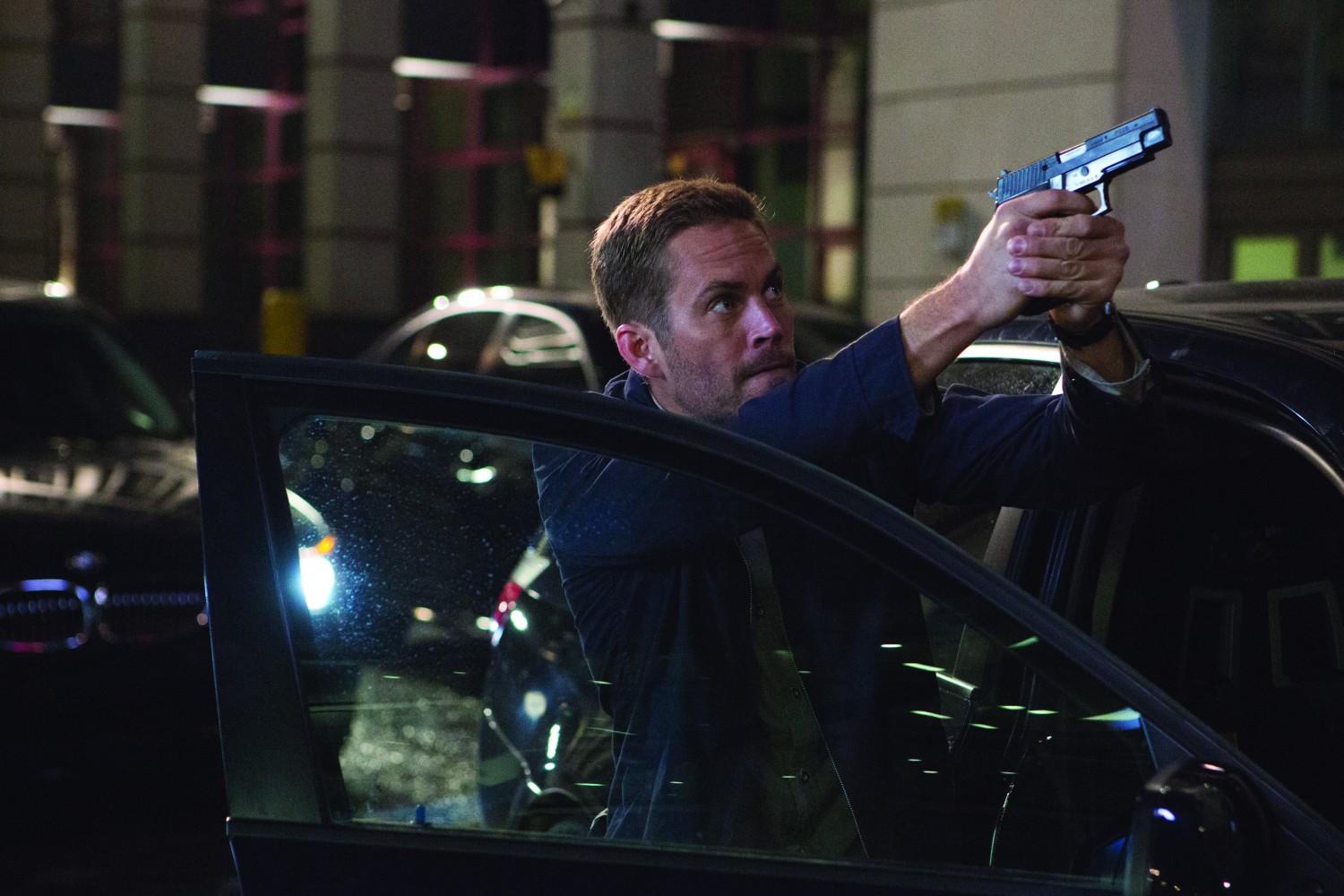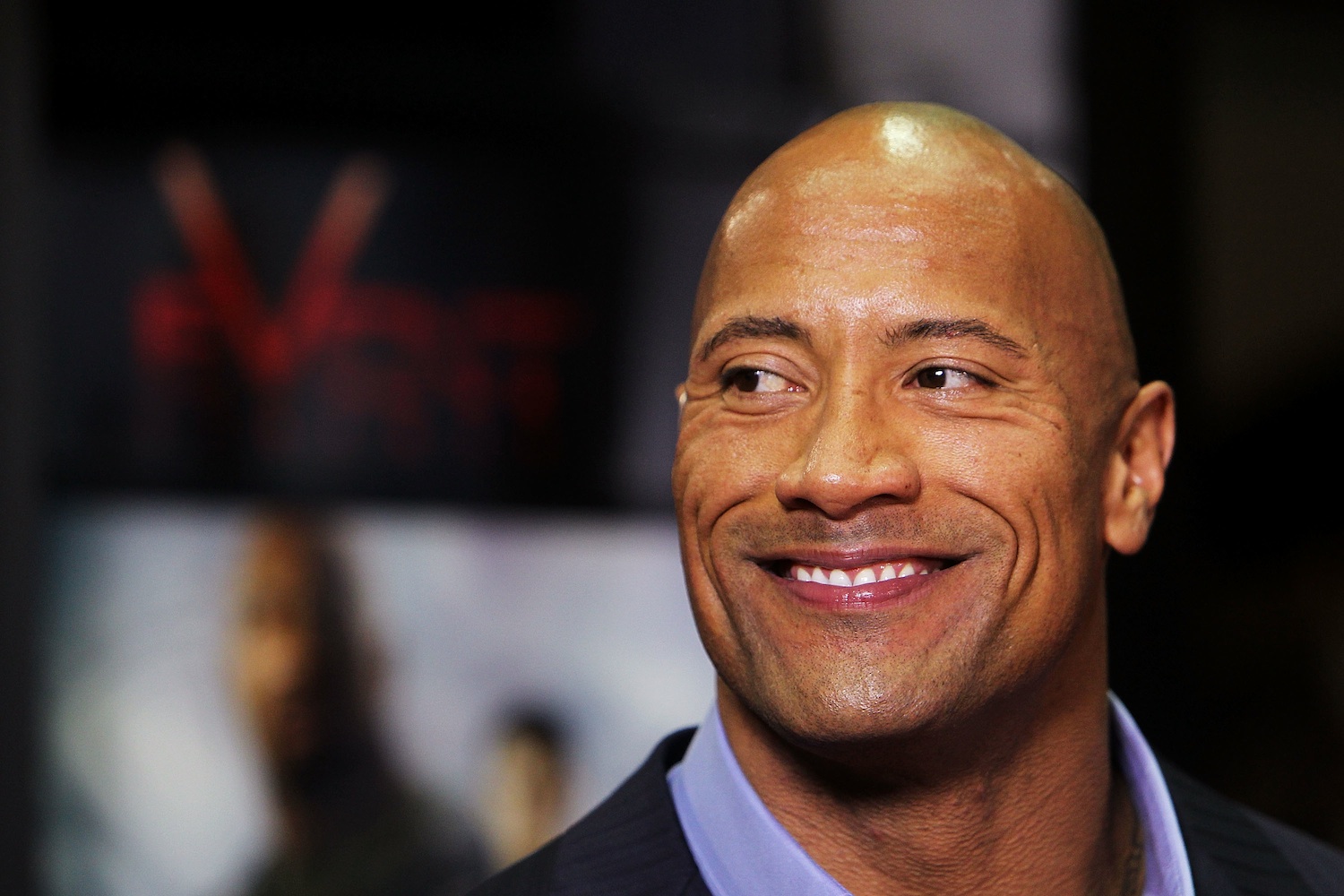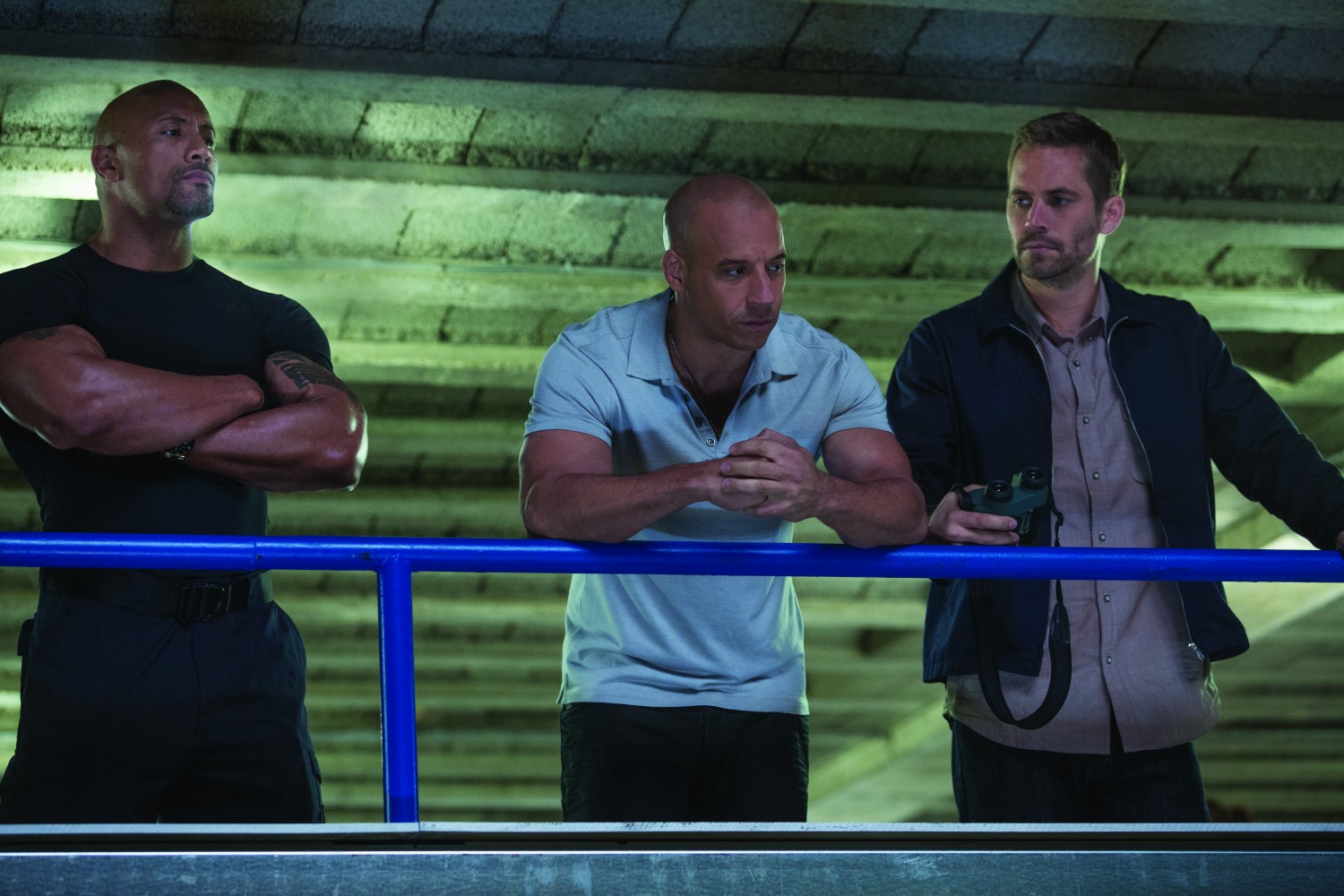
The unqualified success of Fast and Furious 6 — which was the top-earning movie in its second week of release, outperforming even a new film from Will Smith — cemented what many industry insiders had been saying for some time: this high-octane series is poised to become Hollywood’s next great franchise. Here’s how it happened:
The Fast and the Furious opened in theaters on June 22, 2001. Based on a magazine article about New York City’s underground car culture, the movie was about an undercover cop assigned to infiltrate a group of outlaw street racers suspected in a string of robberies. It starred Vin Diesel (fresh off his career-making turn in Pitch Black) as Dominic Toretto, the leader of the gang, and Paul Walker as Brian O’Connor, the LAPD officer sent to bring him down. Opening without a big-name star (and to middling reviews), the film earned a more-than-respectable $40 million on its opening weekend — and was parked among the top 10 earners for another six weeks.
Universal Studios released a sequel, 2 Fast 2 Furious, in June 2003, but without Diesel. The movie — which relocated O’Connor to Miami and teamed him with childhood pal/ex-convict Roman Pearce (Tyrese Gibson) to take down an Argentinian drug lord — debuted No. 1 at the box office with an impressive $50 million haul, but faded quickly because of generally poor reviews and stiff competition from blockbusters like Finding Nemo and Pirates of the Caribbean. The franchise was on wobbly ground: any new installment in the series without the reteaming of Diesel and Walker seemed unlikely.
Instead, Universal blew the whole thing up. The studio brought on the screenwriter-director team of Chris Morgan and Justin Lin (Annapolis, Better Luck Tomorrow) and replaced the entire cast, bringing in Lucas Black, Bow Wow, and Sung Kang (who would end up shaping the franchise in ways Morgan and Lin themselves likely couldn’t have imagined at the time).

Perhaps it was these changes that kept audiences away: The Fast and the Furious: Tokyo Drift was the least successful in franchise history, earning a weak $62 million total at the U.S. box office. As it turns out, these changes saved the franchise.
Lin and Morgan realized they couldn’t rely solely on action-movie elements — they understood that strong characters, a high-stakes story and an underlying mythology would keep audiences invested in the franchise. Still, this overhaul would take a film or two to work out. Something was a bit off in their next installment, simply titled Fast & Furious. Though it reunited Diesel and Walker, the 2009 movie was a bit of a bore, with low-energy action scenes and too many shots of Diesel moping about. While it was the worst-reviewed film in franchise history, F&F still earned enough money at the box office ($363 million worldwide) to justify another installment.
(MORE: Richard Corliss’s Fast Five Review)
That fifth film — simply titled Fast Five — opened in U.S. theaters on April 29, 2011. It was the full realization of the strategy laid out by Lin and Morgan, and elevated the franchise into a global phenomenon.
Here’s how the franchise went about changing its legacy:
1. The studio recognizes the importance of the international market.
The Fast and the Furious made most its money — nearly 70% of its $207 million box-office-returns take — in the U.S., with it successor raking 54% of its $236 million haul on these shores. Each subsequent film, however, has had most of its revenue come from foreign markets. Though Fast & Furious made a plot-necessitated return to Los Angeles, Fast Five established a new paradigm: international settings aimed at a global audience. Gone were the barren deserts of the Mexican-American border, replaced by the stunning, diverse visuals of Rio de Janeiro (well, Puerto Rico portraying Rio). Fast and Furious 6 continued the global pattern, placing nearly all of the action in either London or Spain. Add to that the fact that the fifth and sixth films featured characters from no fewer than four different continents, and it’s easy to see why the franchise has earned a fan base as diverse as its cast.
2. Lin and Morgan embrace the universe that the movies have created.

It would be easy to toss off the return of Dom, Brian, Letty and Mia as an obvious attempt to recapture the excitement and popularity of the first film. But Fast Five makes it abundantly clear that’s not the case. First, their reunion is only just the tip of the iceberg when it comes to bringing back characters from the franchise’s first three films (more on this in a moment). Second, the Dom-Brian-Letty-Mia “family” is the heart of and driving force behind not only Fast & Furious, but also the fifth and sixth films as well.
Then there’s Han, the franchise’s most thoughtful, soft-spoken character, who dies near the end of Tokyo Drift. He returns for the fourth, fifth and sixth films, meaning — wait for it — they’re all technically prequels to Tokyo Drift. Most action franchises would simply pretend that a popular character like Han never actually died. But Morgan has sprinkled his scripts with numerous references to Tokyo — he acknowledges that Han has yet to meet his untimely demise.
3. A new motto: “The more, the merrier.”
Fast Five assembled a veritable Fast and Furious all-star team comprising practically every relevant character from each of the previous films: Dom, Brian, Mia, Han, Roman, Taj from 2 Fast 2 Furious (Ludacris) and Gisele (Gal Gadot), Tego (Tego Calderón) and Rico (Don Omar), all from Fast & Furious. The larger cast made for more conflicts and interactions. In a shrewd move, the filmmakers created situations that allowed supporting characters do their things, rather than thrusting them into the foreground as was the case in earlier films. This shift in emphasis also enabled the franchise’s true star, Diesel, to step front and center.
4. Audiences prove exceptionally eager to smell what The Rock is cooking.

Fortunately, Universal was able to find someone who could stand toe to toe with Diesel. Fast Five added Dwayne “The Rock” Johnson as Luke Hobbs, the Diplomatic Security Service agent tasked with capturing Toretto and his crew. If there’s one thing the F&F franchise had always lacked (O.K., there was always more than one thing, but still), it was a strong adversary for the protagonists — a star on equal footing with Diesel.
In Hobbs, Johnson has created a character with an appealing lack of self-awareness — he’s so over-the-top in his physicality, attitude and actions that he’s practically a parody — the perfect yin to Diesel’s yang. In the new movie, the audience seemingly has no choice but to root for the borderline-abusive Hobbs and cheer the détente that he and Toretto reach at film’s end.
5. Achieving the perfect blend of big action and real humans.
Even though Lin and Morgan began placing even more emphasis on a character-driven story in Fast Five (yes, it does feel weird to type those words), that doesn’t mean they ratcheted down the action. On the contrary, the set pieces are bigger than ever, with Lin proving especially adept at inserting moments of brevity into major action sequences. The film’s final, enormous set piece is the vault heist/chase, wherein Dom and Brian attach a 10-ton vault filled with $100 million to a pair of Dodge Chargers and haul it through the streets of Rio, destroying every car, parking meter and building that gets in their way. See for yourself:
As over-the-top as many of the action sequences may be, they remain accessible because they involve — unlike many blockbusters these days — actual humans. Equally crucial, the characters aren’t talking robots or indestructible superheroes, they’re people that fans of the franchise have grown to care about.
Thanks to these changes, the film was a commercial and critical success, earning $626 million globally and garnering surprisingly strong reviews; TIME’s own Richard Corliss named it one of his 10 best films of 2011. The movie pumped up excitement for the next installment by having Drug Enforcement Administration agent Monica Fuentes (Eva Mendes’ character from 2 Fast 2 Furious) show Hobbs a photo indicating that Dom’s presumed-dead girlfriend Letty might actually be alive.
[ ** SPOILER ALERT: A Discussion of Fast and Furious 6 Below ** ]
Fast and Furious 6, which premiered on May 24, built on both the successful formula of the previous film and embraced the history of the franchise. (The latter is particularly evident in the opening-credits montage that highlights some of the series’ most memorable moments and images.) The movie manages to combine the emotional weight of the fourth film — which centers on Dom’s grief over Letty’s death — with the nonstop, oversize, thrill-a-minute action of Fast Five. This blend succeeds in making Fast Six an actual, honest-to-God good film. Not just good for a Fast and Furious film, not just good for an action movie. A good film, period.
(MORE: Richard Corliss’s Fast and Furious 6 Review)
The basic premise of F&F 6 is that Hobbs persuades Dom and his crew to come out of retirement (earned after pulling the big heist in Fast Five) by telling Dom that Letty is still alive and working with a crew of would-be terrorists. Even though the stakes are higher than ever, the suspense is deftly complemented by the characters’ relationships with one another. To an extent perhaps no other action franchise can boast, the audience actually enjoys spending time with these characters even when they’re not fighting or racing or blowing things up. The banter — no matter how juvenile it may be at times — is fun, and the comfort level that Lin and Morgan achieve makes the moments in between action sequences feel more like a well-scripted television drama (like, say, Justified) than a traditional action movie.

Great action franchises make audiences fall in love with the star — John McClane, Indiana Jones, Sam Witwicky (kidding) — and relish every moment they’re on screen, but they’re rarely as successful at making audiences care about the supporting cast; that’s not a problem in Fast and Furious 6. Equally important is the fact that Lin and Morgan haven’t lost track of the series’ origins. Even if street racing is no longer the focal point of the films, Dom and Brian always find time to square off, whether they’re speeding down the streets of Rio for $1 million (Fast Five) or racing to reach Mia as she goes into labor (Fast and Furious 6).
Also handled well in Fast 6 are the tragic fates of Han and Gisele. In order for Han to end up in Tokyo mentoring a 17-year-old American expat, he’ll need to have fallen on some pretty hard times. What better way to accomplish that than by killing off Gisele in the most heartbreaking way possible? Even in the film’s final scene — a peaceful, satisfied barbecue at the Toretto house — it’s evident that Han is well on his way to becoming the world-weary soul we see in Tokyo Drift. But that’s not the end of Han’s story in Fast 6.
While everyone thought they knew how and why Han died in Tokyo Drift, we learn his demise may be far more connected to the Toretto crew than anyone could have imagined. See, the lead villain in Fast 6, Owen Shaw, has a brother whose identity — after examining clues — just might be a character known as The Transporter (and made famous by Jason Statham. We don’t know for sure if Statham will be reprising his role as the cinematic wheelman in Fast and Furious 7, though he is attached to the film in some capacity) — but we sure are hoping.
[ ** END SPOILERS ** ]
Oh, and they’re definitely making a seventh Fast and Furious movie, slated to hit theaters next summer (Diesel says he hopes for a trilogy of trilogies). And why wouldn’t they? Fast & Furious 6 opened to $120 million over Memorial Day weekend at the domestic box office. Each film in the series (save for Tokyo Drift) has opened bigger than its predecessor, practically unheard of for a franchise of any kind (even Harry Potter stumbled with The Order of the Phoenix and The Half-Blood Prince).
What’s more, critics don’t appear to be souring on the series at all (Fast 6 earned a 78% fresh rating among top critics on Rotten Tomatoes). Adding Statham to the mix, along with Diesel, Johnson and the rest of the gang demonstrates Universal believes Fast and Furious is stronger — and bigger — than ever. Not bad for a 12-year-old franchise that had a rough start off the line.
More Must-Reads from TIME
- Donald Trump Is TIME's 2024 Person of the Year
- Why We Chose Trump as Person of the Year
- Is Intermittent Fasting Good or Bad for You?
- The 100 Must-Read Books of 2024
- The 20 Best Christmas TV Episodes
- Column: If Optimism Feels Ridiculous Now, Try Hope
- The Future of Climate Action Is Trade Policy
- Merle Bombardieri Is Helping People Make the Baby Decision
Contact us at letters@time.com